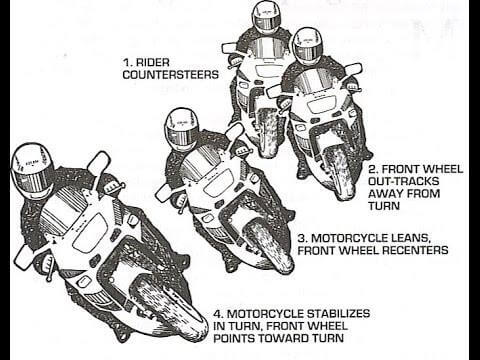RIDING SKILLS: Steering

 Image: Reddit
Image: Reddit
It seems like we hear about so many cases of motorcycle accidents every time the weekend comes around, especially in the vicinity of twisty roads. Apart from being hit by a car or two, the bulk of the cases concern bikes overshooting corners, or unable to avoid dangers on the road.
Too much speed (going in too hot) or skidding aside, overshooting a corner or not being able to get out of the way results from the inability to steer the bike effectively.
There are many myths out there about how you should steer your motorcycle. Among them are:
- Using your bodyweight “to pull the bike down”, better known as “hanging off”
- Pushing down on the footpegs with the feet
- Pressing the handlebar downwards
- Positioning the body to the outside of the turn and pushing the bike down
- Twisting the torso and shoulders into the turn
The first three techniques aren’t entirely wrong, but you may find yourself going wide in corners, should you depend on any one of those techniques alone. It’s also the main reason why some riders are so slow through corners, trying to keep their bike from overshooting.
So how does one steer?
Without going through a physics dissertation, I’ll talk about the obvious that motorcycles, having two wheels in tandem, do not steer like cars. In a car, you only need to turn the steering wheel into the direction you wish to go i.e. turn right to go right, but it’s not so simple with bikes due to the forces acting on the wheels, while being connected directly to the bike via the headstock.
Here’s how you should learn to steer a motorcycle:
- Look for an open parking lot or straight road without traffic and position your bike in the middle of the lane
- Sit straight and relaxed on your bike without leaning your body off the seat
- Take your bike up to 60 km/h (or faster)
- Push forward (not downwards) on the left handlebar. Your bike will lean and turn to the left
- Now push on the right side of the handlebar. The bike will lean and turn to the right.
- You may also pull on the handlebar for this to work. For example, pull on the right side for the bike to turn left.
Congratulations, you’ve just learned “countersteering”.
It’s exactly how the pros turn their bikes. The bike won’t turn effectively at speed if they weighted the motorcycle using their bodyweight alone. See how they hold just one side of the handlebar while the bike is leaned over in a corner?
Yep, countersteering.
The bike’s turn-in rate depends on the force of your steering input. Push hard on the handlebar and the bike turns in faster. “Row” the handlebar in a smooth manner and the bike drops in slower. You may also push and pull on the opposing sides of the handlebar to snap the bike over.
Your next course of action is to deduce the correct amount of force required for a faster or slower steering response, depending on the speed and characteristics of your bike. The slower the speed, the lighter the bike, and similarly if the tyres are narrower, the less force is needed. And vice-versa.
You may get away with body steering on a scooter due to the low weight, narrow and light tyres, lower seating position, and relatively slower speeds compared to a big bike’s, however, attempting so on a bigger and heavier bike with wider tyres WILL have you running straight instead of turning into the corner!
Ah, you may say, “Hey, the bike turns when I lean my body into the corner”. That happens because you are already performing countersteering, only that you’re unaware of it, as you’re actually pushing on the inside handlebar, causing the bike to countersteer.
However, learning to countersteer consciously is important as the technique is applicable anywhere at anytime, even if you’re not particularly a corner junkie. Countersteering works for all types of motorcycles.
Imagine you’re riding one day and a car chops into your lane, or a pothole appears out of nowhere. Will you have the time to lean your body to turn the bike and avoid it? You won’t. The best way then, is to push (or pull, or both push and pull) the handlebar to swerve out of the way.
How about in the middle of a corner, when you’re already leaned over?
If the bike is trying to go wide, just push on the inside bar and the bike will tighten its line. To lift the motorcycle back up at corner exits, push on the outside bar.
Keep practising countersteering every time you ride until it becomes second nature, and you will soon find joy not only for cornering, but safer riding overall!
Just remember:
Push left to go left;
Push right to go right.